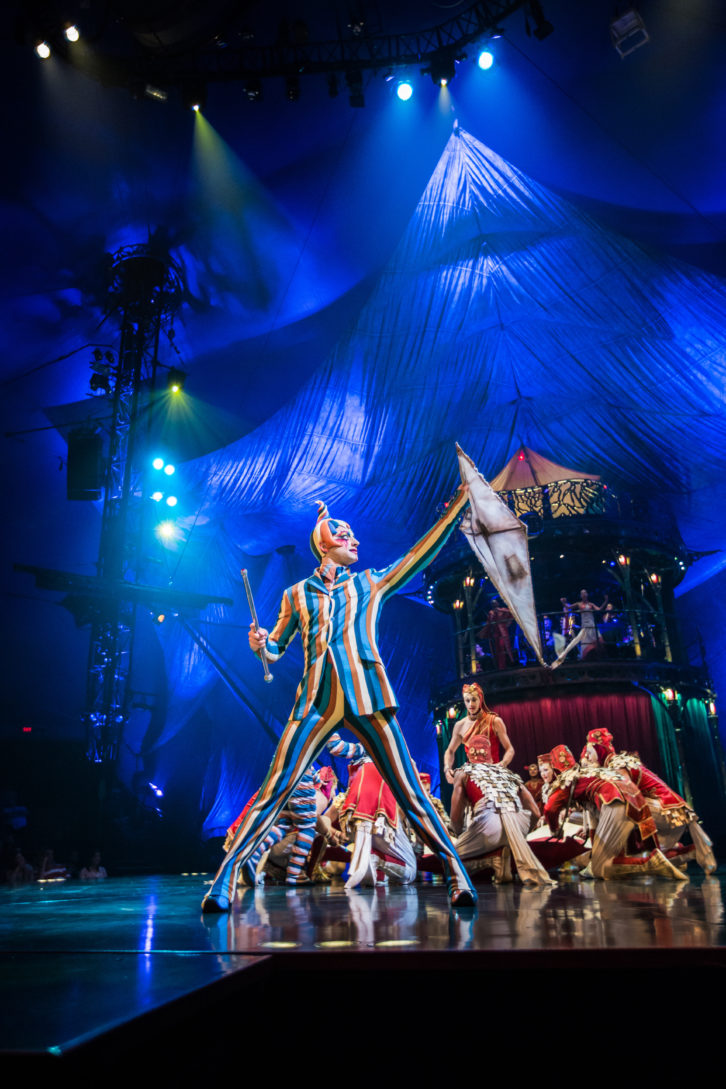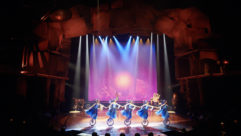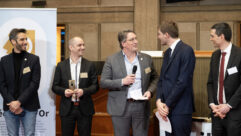The shows are a visual extravaganza but these shows’ most challenging job may just be Cirque du Soleil audio. Music playback, effects and creatively hidden Sennheiser microphones are all in the mix. Sound Specialist Matthew Steuart has the story on how he makes all that magic sound work, coming up on the SVC Podcast.
From Sound & Video Contractor Magazine this is the SVC Podcast, show 266 with Matthew Steuart about his work on Cirque du Soleil audio.
Matthew, thanks for getting with us from Cirque du Soleil headquarters in Montreal with a backstage look on how the show’s sound comes together.
Yeah, it’s my pleasure.
So how long have you been working with Cirque du Soleil audio?
I’ve been with Cirque for 14 years now. I started on a tour called Corteo in 2008.
Well I guess you’ve got the whole drill down pretty well by now then.
Yes. I’m not the longest-running tech, that’s for sure. There’s others that have had many more years than me. But yeah, 14 is pretty good I’d say. [Timestamp: 1:08]
And what does being the Sound Specialist for this Cirque du Soleil show involve? It sounds like you’ve got a full plate.
Full plate indeed, yes. I work in a technical show support department, so I have myself and my colleagues look after all the technical equipment requirements, upkeep, maintenance, and conformity for all of our touring shows. My scope is the sound equipment, I take care of anything to do with sound on our touring shows. So yes, it is quite a bit. And especially in this relaunch that we’re in now where we’re slowly, but not so slowly, putting our shows back on the road. [Timestamp: 1:43]
Yes, that sounds like a mighty big job and we’re going to talk about that. I was interested because I’ve seen one of these shows. How long does it usually take to get one of these shows ready to go say for that night?
If we’re talking about from being set up and it’s a show normally it’s a couple of hours of presets. If we’re talking about rolling into a city it’s about a week, let’s say 10 days, of set ups it takes to get the show ready. That’s a big top show. But if we’re talking from scratch when they’re creating the show, this is several months of work that will take place beginning with concepts and then they’ll hire designers that will come up with all that, the set design. And then they’ll build the show in the studio here in Montreal and then they’ll practice everything there. Then once that’s in good shape they’ll move it into the big top, continue rehearsing in the tent, and then eventually open it. And then they go on tour and the shows just tour and tour and tour. [Timestamp: 2:39]
And it just sort of happens. I know you got an unusual situation as everybody did with the pandemic and having to take some time out. You turned that into an advantage upgrading to the Sennheiser Digital 6000 RF mic system.
Yes. Well, when Covid struck, obviously everybody in entertainment were also shut down. And in shutting down what happened was a lot of equipment had to be either repatriated or stored. So in preparation for putting the shows back on the road, we decided to would be prudent to test everything first. So slowly what we did was each specialty, like I said, we went through all of our equipment on each show and verified that it was all still functioning, it was all still going to be able to tour in the state of it. Then we took on any little projects that we were able to do in the time before the show was meant to go back on the road. So yes, we did end up upgrading a couple of shows to the Sennheiser Digital 6000 wireless systems because we had the opportunity and it was the perfect time to do it. So yes, absolutely we did that. [Timestamp: 3:40]

I would think that one of the biggest challenges for taking a show like this out on the road and performing in many different environments is frequency coordination. You have more RF sources and shrinking allocated bandwidth. These mics have the Sennheiser Link Density Mode that allows you to cram more channels into the same space. How does that work?
Yeah, that’s correct. It’s a new firmware that Sennheiser put out, I think, just before Covid. I’m not one hundred percent sure, exactly, but it offers this Link Density Mode, as you said, which will allow us to put carriers down to, I think, it’s 200 kH apart, which is fantastic. So like you said, in challenging or crowded RF environments being able to get many more carriers closer together is just phenomenal. It really is fantastic. Because like you did say as well we are traveling. The shows do move around. And one thing that’s interesting is we do play in a tent, right? So there’s pretty much nothing in terms of RF shielding from any outside interference. So like even DTV stations in cities that are – in a theater you would not really worry about. Because we’re outside we’re seeing those things so we can actually avoid them. So any advantage we can get, of course, to be able to have the microphones we need tuned up and to have them be reliable is also very important. So yeah, that Link Density Mode has already come in handy for us for sure. [Timestamp: 4:59]
And then on the other end of it you have what some might call low tech solutions in being able to hide the mics and transmitters on the performers. You’ve got to use some creative costume solutions.
Yes, well that’s our wardrobe department. They’re fantastic. They’re able to take these little microphone packs and hide them in all sorts of places. And it’s a combination of looking at the act, at the artist, what they’re doing, and then also if perhaps we may need to remove that microphone during the performance so it has to accessible as well. So it’s a really great collaboration, I’d say, between the artist, the wardrobe department and ourselves to come up with the best solution. But like you said, low tech. Yes, Velcro still has its place. [Timestamp: 5:34]
Yes, good old Velcro and maybe even a little duct tape as well.
[Laughs] Maybe. Sometimes.
How does the size of those Sennheiser MK6212 body pack transmitters compare to others? I think they’re even a little smaller than most.
Yes. So previously we would have been using the Sennheiser SK5212, which was also very small. But somehow they managed to get these 6212s even smaller. And with the new batteries that Sennheiser is using, I think the 6212 is giving us something like 13 hours of battery life. It’s pretty amazing, something so tiny is it can run that long. So they’re really great how small they are. And even more opportunities, I would say, to put these microphones in different places or easily-accessible places on some of our performers. [Timestamp: 6:19]
We were talking earlier about frequency coordination. When you’re taking this on the road that’s a tough job. How does the Sennheiser Wireless Systems Manager software help you with that?
Oh yeah, WSM is great. I mean, first of all it’s tied with the Sennheiser chip that we’re using so we can run scans through there, we can save and share scans with other tours. We can run several different configuration options and take a look at how it’s going to look. It also has a great feature where we can actually coordinate and store spare frequencies so if ever there was an issue we have something spare that’s pre-coordinated and you can just drop it in the software with a little click. It’s really great. [Timestamp: 6:59]

That would really be bad to have to go looking for another frequency during the live show. You sure don’t want to have to do that.
No, absolutely not. So you just open up this little spare frequencies box – actually, I think the icon is a life ring, which is fitting – and you just have your frequencies that were pre-coordinated as spares ready to go. So that’s super useful for sure. And then on top of it, it does, like it says, monitoring as well so we’re able to keep an eye on RF levels of all the transmitters and battery levels as well. So it’s all there. [Timestamp: 7:28]
With RF you never know what you’re going to run into for sure.
Well, that’s it, right? As soon as you transmit that in the air you’re taking a gamble, right? There’s nothing protecting it at all. So the most you can prepare to be ready for any eventuality, of course, we’re going to take those. [Timestamp: 7:43]
What do you do on the control end of it as far as mixers, compressors? You’ve got to really have the show script down well but what do you use to mix it?
Yes, so every show has a slightly different console or system, I guess, depending on when the show was created. So the newest shows that we’re working with we’re mixing with the Avid S6L console. And then they’re using that both at front of house and monitors, so that’s nice to have the same desk. We had used the Avid Venue previously. Some of the other shows that the Meyer Cue Station and LCS or D-Mitri rigs, which is very cool. It depends on when the show was created and what was available at the time. [Timestamp: 8:19]
And on the performer end of it, they’ve got to be able to hear what’s going on to get their cues. How do you handle sound monitoring?
That’s a good question, actually. The tent itself, even though it’s called the Big Top, isn’t all that big. So everyone on the stage is going to hear what’s being played through the PA absolutely. But there are occasions where we have some IFB modules that we may need to use, like an in-ear pack that the stage manager calls go into so we can hear what’s happening. But for the most part, the PA for the Big Top will sufficiently cover what’s on stage and people are able to hear that. We may end up having a couple of monitors that are more directed towards the stage, let’s say, but I wouldn’t say it’s absolutely necessary. For the musicians, however, band members that are playing the music, they’re all entirely plugged in-ear, wireless in-ear monitors so they’re wearing in-ears throughout the show. So that’s what they’re able to keep track of everything with. [Timestamp: 9:10]

I guess a central part of that is for the musicians to be able to also hear the performers.
Yes, it depends. I mean, sometimes the clowns and things like that will have cues that the band will need to hear. But some performers’ acts are silent, right, so they wouldn’t need to hear it. So just again, a case-by-case thing that we’ll look at what’s required for everybody to do what they need to do and make it happen. [Timestamp: 9:32]
Now when you’re actually doing one of these shows, how has the pandemic affected the technical aspects of the show? Has it caused you to have to do anything substantially different during the production?
I’d say what it’s given us is just a bit more cleaning. So cleaning microphones, cleaning in-ears, cleaning headsets, coms, consoles. Just keeping stuff a little more tidy than we would have before. There have been a couple of cases where we’ve had to soundcheck singers while they’re wearing masks, which isn’t really ideal. But again, we just have to roll with the punches and see what’s coming. And we’re just all so happy to be back working again and putting shows on for people, that I guess these are just minor inconveniences, I would say, in the grand scheme of things. [Timestamp: 10:14]
It probably makes them sound like they’re under a pillow, trying to do it with a mask on.
We’ve tried several masks, let’s say, to see which one impedes the sound the least, I guess, or colors it the least. And then you have to do some compromise on the other end, so there’s some EQing that may have to happen. It’s not ideal, but it’s better than not working. [Timestamp: 10:32]
That’s for sure, and the other critical aspect of coordination is playbacks. Are you frequently rolling in things?
So yes, there is a playback system that we run, they’re all based around Ableton Live. So that will have a guide track for the musicians and occasionally some sweeteners, some instrumentation that they’re not able to reproduce. What’s interesting is in the show we have a bandleader that’s driving the Ableton set, but also watching the performers on stage so the music in the show is reacting to the acts. So there are sections that may loop or may be extended or things that are cut short just depending on what’s going on on stage. There is playback, but it’s following the show, right, and the bandleader is following the show as well and calling those changes out to the band as well. So it’s a pretty spectacular thing to watch and hear especially on the in-ear to listen to this thing. Every night they’re just slightly different. Every night the show is just a little bit different because this guy took a little bit longer to do this move he normally does or whatever. So there’s just an infinite amount of possibilities. [Timestamp: 11:38]

Yes, the human aspect of it is always going to be somewhat unpredictable, and being a live show, one of the keywords would be backups. Backups for everything.
Yes. There’s a lot of redundancy built into our systems, absolutely. As I mentioned the playback rig. We have redundancy there. There’s redundancy in a lot of the system. But we’ll also take a look at what’s critical, like what would stop the show and what can we maybe get by with because we’re also up against track space is not infinite. Budgets are not infinite either. So we have to really look at what’s critical to have backups for and what are things that oh, we can work around that should there be a problem. Yeah, definitely redundancy is important. [Timestamp: 12:17]
Do you ever get into some acoustically noisy environments where you have to compete against any exterior sounds going on?
Like I mentioned earlier, the tent being essentially outside, it has happened where we’ve been in parking lots next to concerts with PAs much larger than ours. Or who knows, traffic, airplanes, we hear that stuff too. I think there was one city where we were stationed next to a train track, so there was often train horns honking. You could hear those without a doubt. It would be like standing right next to it. [Laughs] So you just have to grin and bear it. [Timestamp: 12:52]
That’s just amazing how you coordinate all of that, making sure the RF is right and then operating it during the show when not everything is predictable. Incredible the way you pull it off.
Well, it’s a team effort absolutely. There’s many people involved and everybody has their part to do. It wouldn’t happen without that, so it is pretty spectacular when you step back and look at everything that’s been done or that has to be done, but it really is a team effort to get these things going. [Timestamp: 13:19]
And what are the show’s plans now?
Well, it depends. If we’re speaking about Kooza, for example, Kooza is currently in the Dominican Republic and their next city is going to be Montreal. So they’ll be coming back here for the summer. And we have other shows that have started to move around. We’ve had OVO that’s just opened up in Louisiana. We have Luzia, which is running in the Royal Albert Hall in London currently and they’ll carry on a tour in Europe. Then there’s a few more that we’re finishing up the relaunch, I guess you could say, and they’ll be hitting the road later this year. [Timestamp: 13:50]
Well, I know that audiences are going to be just blown away by the sheer energy and precision of the performances. We’ve been talking with Matthew Steuart, Sound Specialist for Cirque du Soleil. It’s been great to hear how all of these incredible productions get put together behind the scenes and congratulations on doing such a tireless and professional job getting it all ready and pulling it off every time. Thanks for being with us.
Thank you very much. It was a pleasure.
Cirque du Soleil audio has gone to the next level with the Sennheiser 6000 digital wireless mic system and it’s ready to immerse audiences in a first-class sound experience. We have more AV tech stories from the front lines of entertainment so be here for the next one on the SVC Podcast.










